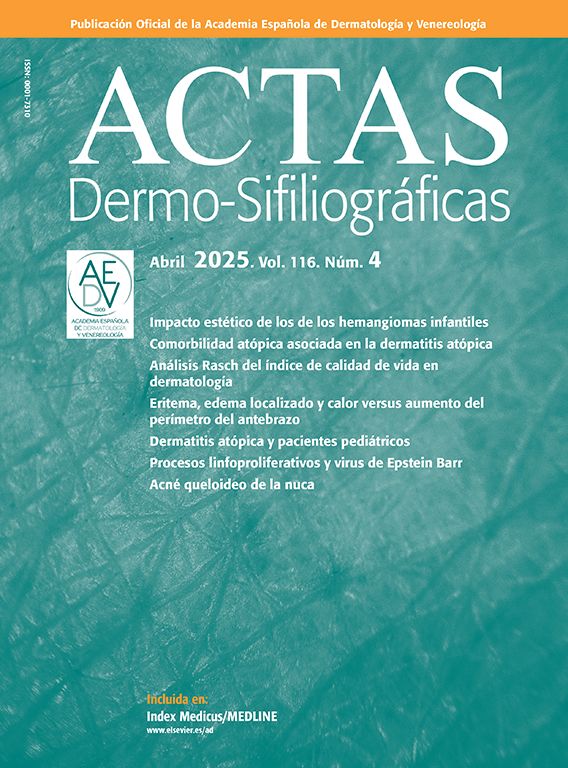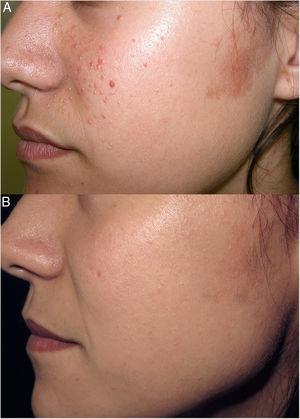Chronic pruritus is defined as a >6-week history of itching and is associated with a significantly reduced quality of life.1 Although chronic itch frequently arises on inflamed skin, patients can experience pruritus without any skin signs being present except for possible secondary scratch lesions.1 Although many systemic diseases can lead to itch, including endocrine and metabolic disorders, infections or hematological diseases, the most common ones are chronic kidney disease and cholestatic liver diseases.1
When itch without any visible cutaneous changes appears only in response to increased core body temperature, sunlight exposure, physical activities, warmth, emotional stress, or hot/spicy food intake, the diagnosis of cholinergic itch can be contemplated.2 Cholinergic itch is considered as part of the spectrum of cholinergic urticaria,2 yet no specific clinical practice guidelines address the diagnostic workup or treatment of this condition.
We report the case of a 64-year-old man with no relevant past medical history who was referred to our dermatology clinics in March 2021 with a 2-year history of pruritus without skin lesions, which remained unresponsive to antihistamines and phototherapy. The patient reported intense generalized pruritus that appeared after hot showers and in situations leading to sweating, such as walking or emotional stress. Physical exam turned out normal and initial Coulter counters and biochemical profile showed no changes. Omalizumab proved ineffective, and further therapeutic trials with cyclosporine, montelukast, dupilumab or gabapentin provided no further benefit, with significant deterioration of the patient's quality of life. Since, in October 2022, Coulter counters revealed the presence of thrombocytosis (426×109/L), the patient was referred to the Hematology department. A V617F JAK2 mutation was found in peripheral blood and in March 2023 a bone marrow biopsy confirmed the diagnosis of essential thrombocythemia (ET). Treatment with hydroxyurea led to normalization of platelet counts but no improvement of pruritus. Eventually, on May 2023, a joint decision was made to start ruxolitinib 10mg twice daily with immediate pruritus relief.
Chronic pruritus can appear in almost 50% of patients with myeloproliferative neoplasms (MPN), mainly in polycythemia vera but also in ET.3 Aquagenic pruritus – that begins after contact with water at any temperature – is the most common type of pruritus observed in these patients.3 As far as we know, this is the first case describing ET-related cholinergic pruritus.
An acquired single point mutation in JAK2 – usually in the pseudokinase domain (V617F) – which leads to constitutive activation of tyrosine kinase, is a common pathogenic finding in MPN and can be found in 50% up to 60% of ET patients.4 The JAK-STAT signalling pathway is the major intracellular signal transducer for cytokines such as interleukin (IL)-4, IL-13 or IL-31, representing essential signalling pathways in various inflammatory skin diseases and pruritus.5 However, pruritus in MPN can appear in the absence of JAK2 mutation, suggesting other contributing mechanisms for pruritus in MPN.4
Ruxolitinib is a JAK1 and JAK2 inhibitor approved for treatment of polycythemia vera and myelofibrosis, but not for ET.3 In ET, its clinical efficacy in terms of disease control is modest,4 but it has been shown to provide control of itch regardless of JAK2 mutation status.4 Thus, it has been proposed as an alternative for patients with a significant symptom burden, as in the case presented herein.
The benefit of JAK inhibitors to control chronic pruritus, mainly in cases of atopic dermatitis, has already been shown.6 This is the case of oral upadacitinib, abrocitinib (JAK1 inhibitors) or baricitinib (JAK1 and JAK2 inhibitor) and topical delgocitinib (pan-JAK inhibitor) or ruxolitinib.5,6 In fact, 1.5% ruxolitinib cream has been approved by the U.S. Food and Drug Administration to treat mild-to-moderate atopic dermatitis in non-immunocompromised patients aged ≥12 years whose disease is not adequately controlled with topical prescription therapies or when those therapies are not advisable; the response rate regarding itch (≥4 point improvement in the Numeric Rating Scale) in clinical trials is >50% on week 8.7
This case illustrates the importance of a repeated systematic diagnostic workup in patients with chronic pruritus without skin lesions. Since pruritus can precede the hematological diagnosis for many years,3 when the dermatologist is confronted with refractory chronic pruritus the analytical workup should be repeated to pursue the etiologic diagnosis, thus allowing a specific etiological treatment that can lead to complete pruritus resolution.
Conflicts of interestL. Mateu-Arrom, none declared.
E. Serra-Baldrich has received fees as a consultant/speaker and/or participated in clinical trials funded by AbbVie, Almirall, Galderma, LEO Pharma, Lilly, Novartis, Pfizer, Pierre Fabre, and Sanofi.
L. Puig has received fees as a consultant/speaker and/or participated in clinical trials funded by AbbVie, Almirall, Amgen, Biogen, Boehringer Ingelheim, Bristol Myers Squibb, Janssen, LEO Pharma, Lilly, Novartis, Pfizer, Sandoz, Sanofi, and UCB.





